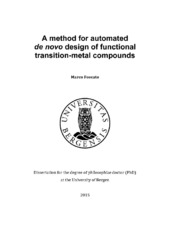A method for automated de novo design of functional transition-metal compounds
Doctoral thesis
Permanent lenke
https://hdl.handle.net/1956/10456Utgivelsesdato
2015-10-05Metadata
Vis full innførselSamlinger
- Department of Chemistry [433]
Sammendrag
Systematic application of automated design methods in transition metal and organometallic chemistry is hampered by the limitations of computational tools traditionally developed according to organic chemistry formalisms. Such tools are often inadequate to deal with peculiar chemical entities such as organometallic catalysts. Therefore, the present study aims to develop methods for generating and handling special chemical entities in the context of automated molecular modeling and de novo design. We introduced a set of formalized and versatile rules to guide automated mining of molecular fragments to be used for construction of new and synthetically realistic chemical entities with punctual control over metal coordination environments. The preparation of initial three-dimensional (3D) molecular models was made independent from tedious force field parametrization by exploiting geometrical information taken from crystallographic structures or computed models and stored in 3D fragments. The method demonstrated superior performance in the preparation of 3D models for tree-like structures of peculiar compounds and also capability of handling chemical entities that are beyond the scope of regular tools. Design of multyciclic system from acyclic 3D building blocks was achieved by including methods for the identification of closable chains of fragments and ringclosing conformational adaptation. The overall machinery, which was integrated into a previously developed evolutionary algorithm for de novo design, was coupled with the computationally inexpensive ligand field molecular mechanics (LFMM) method, which was implemented in Tinker as part of this work, and applied in the design of new Fe(II) spin crossover compounds with multidentate amine ligands. New potential spin crossover compounds with unexpected, yet realistic ligands were identified and proposed for further investigation. In conclusion, while refinement of the implementation is proposed to improve efficiency, the overall de novo molecular design method developed in this study contributes to empower the application of automated design strategies in transition metal and organometallic chemistry.
Består av
Paper I: Automated Design of Realistic Organometallic Molecules from Fragments. Foscato, M.; Occhipinti, G.; Venkatraman, V.; Alsberg, B. K.; Jensen, V. R. J. Chem. Inf. Model. 2014, 54, 767–780. Full text not available in BORA due to publisher restrictions. The article is available at: http://dx.doi.org/10.1021/ci4007497Paper II: Automated Building of Organometallic Complexes from 3D Fragments. Foscato, M.; Venkatraman, V.; Occhipinti, G.; Alsberg, B. K.; Jensen, V. R. J. Chem. Inf. Model. 2014, 54, 1919–1931. Full text not available in BORA due to publisher restrictions. The article is available at: http://dx.doi.org/10.1021/ci5003153
Paper III: Integration of Ligand Field Molecular Mechanics in Tinker. Foscato, M.; Deeth, R. J.; Jensen, V. R. J. Chem. Inf. Model. 2015, 55, 1282–1290. Full text not available in BORA due to publisher restrictions. The article is available at: http://dx.doi.org/10.1021/acs.jcim.5b00098
Paper IV: I’ll Give You a Ring: Ring Closure to Form Metal Chelates in 3D Fragment-Based de Novo Design. Foscato, M.; Houghton, B. J.; Occhipinti, G.; Deeth, R. J.; Jensen, V. R. Full text not available in BORA.
